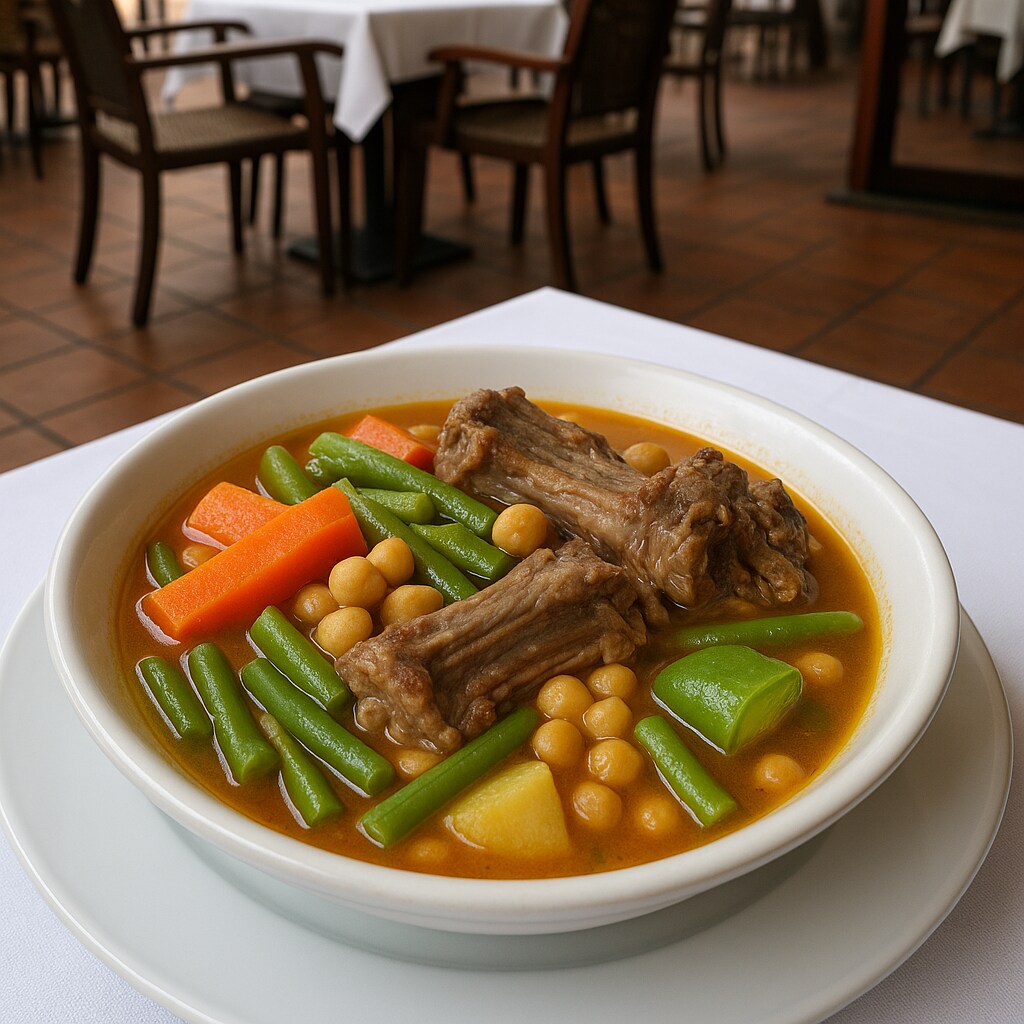The term “Potaje” refers to a category of soups, stews, or porridge, where meat, vegetables, grains, fruit, or a combination of these ingredients are boiled together with water, broth, or other liquids.
The variations of this dish are countless and mainly depend on the variety and regional availability of the ingredients.
This means that on menus, the word “potaje” appears accompanied by the prepositions “with” or “of”, naming the variations, for example: “potaje with/of chard” (stew with/of chard), stew with onions, etc.
One of the fundamental dishes of Canarian gastronomy, where we find different recipes depending on the island and the country.
Generally, the Canarian potaje contains pumpkin, onion, garlic, bell pepper, chard, potatoes, corn cobs, sweet potato, bubango (a type of squash), zucchini, cabbage, watercress, and also some type of legume, like beans, chickpeas, or peas.
In some areas, like the north of La Palma and Tenerife, beans or chickpeas may be replaced by wheat.
Occasionally may also contain meat products, like a piece of bacon, shredded pork, ribs, etc. Depending on the area, meat is used to reuse leftovers from other meals.
The meat broth is often used to scald the gofio (a food made from unrefined flour of roasted grains) and prepare scalded gofio, which is eaten with pork (both short and fat) or canned sardines as a first course before the stew.
It can also be turned into escaldón gofio, by mixing gofio with meat or fish broth.
On our last evening in Gran Canaria, during our trip in March 2021, we tasted one of the most typical of the Canary Islands: with vegetables, chickpeas and pork ribs.
Ingredients are always cooked in order of hardness.

- Difficulty: Very easy
- Cost: Very cheap
- Preparation time: 10 Minutes
- Portions: 4 people
- Cooking methods: Boiling
- Cuisine: Spanish
Ingredients
- 9 oz cooked, boiled chickpeas (if dry, soak overnight)
- 0.88 lbs pork ribs
- 1 carrot
- 5.3 oz potatoes
- 1 green bell pepper
- 5.3 oz zucchini
- 3.5 oz green beans
- 8.5 cups meat broth
- 1 packet saffron
- 3 cloves garlic
- to taste parsley
- to taste olive oil
- to taste salt and pepper
Preparation
Cut the vegetables into small pieces, placing them in a tall pot.
Set aside the potatoes to add them when boiling.
Place the harder and more substantial vegetables at the bottom, lay the ribs on top, and finally the more fragile vegetables and chickpeas.
Add the meat broth, oil, and salt.
Chop the parsley with the garlic, adding oil to form a homogeneous paste.
Mix the paste with the vegetables along with the saffron.
Cover and bring to a boil.
Cook for 45 minutes over medium heat, stirring occasionally.
At the end of cooking, let it rest for 10 minutes before serving.
Other Canarian Soups:
Here are other typical soups from the Canary Islands:
– potaje de berros (watercress soup: an edible plant from the Brassicaceae family);
– the potaje de coles (cabbage soup);
– the potaje de lentejas al estilo canario (lentil soup);
– the puchero (mixed boiled vegetables and greens);
– the caldo de papas (potato broth), based on potatoes and cilantro;
– the rancho canario (Canarian stew), based on chickpeas, short pasta, potatoes, and meat;
– the caldo de millo (corn broth) with corn, chickpeas, and garlic;
– the caldo verde with potatoes, parsley, eggs;
– the ropa vieja with chickpeas and meat, prepared with leftovers from the boiled dish.
– the ropa vieja with chickpeas and meat, prepared with leftovers from the boiled dish.
Much like our minestrone, the suggestion is to always use seasonal vegetables. You can follow the guidelines of this book: Seasonal Fruits. Month by month the fruit and vegetables to consume at €3.32
Where does the word potaje come from?
The term potaje is reminiscent of the French pot-au-feu, when in reality it is more similar to a stew or casserole, or to the French potage, a term used for any vegetable soup.
Are Puchero and Potaje the same recipe?
“Puchero” and “potaje” are two terms referring to similar dishes, but with some differences, especially in the context of the Canary Islands and Spanish cuisine in general.
🔸 Puchero
It is a richer and more complex stew.
Typically includes a wide variety of meats (beef, pork, chicken), chickpeas, and many vegetables (potatoes, cabbage, pumpkin, carrots, etc.).
It is often served separating the broth, vegetables, and meat into multiple courses.
Considered a festive dish or for special occasions.
🔸 Potaje
It is a simpler, everyday dish.
Usually contains legumes (chickpeas, beans, lentils), a single meat (sometimes just bacon or chorizo), and vegetables.
Served in a single course, like a thick soup.
Typical during Lent (like the Colombian Potaje de vigilia) or as a home-cooked meal.
In the Canary Islands:
The Canarian puchero is much more sumptuous, a great traditional dish.
The potaje de vigilia, for example, is a simpler version, made without meat and consumed during Lent.
So, they are not the same thing but share common roots: both are legume and vegetable-based dishes, but puchero is more elaborate, while potaje is humbler and “everyday”.

